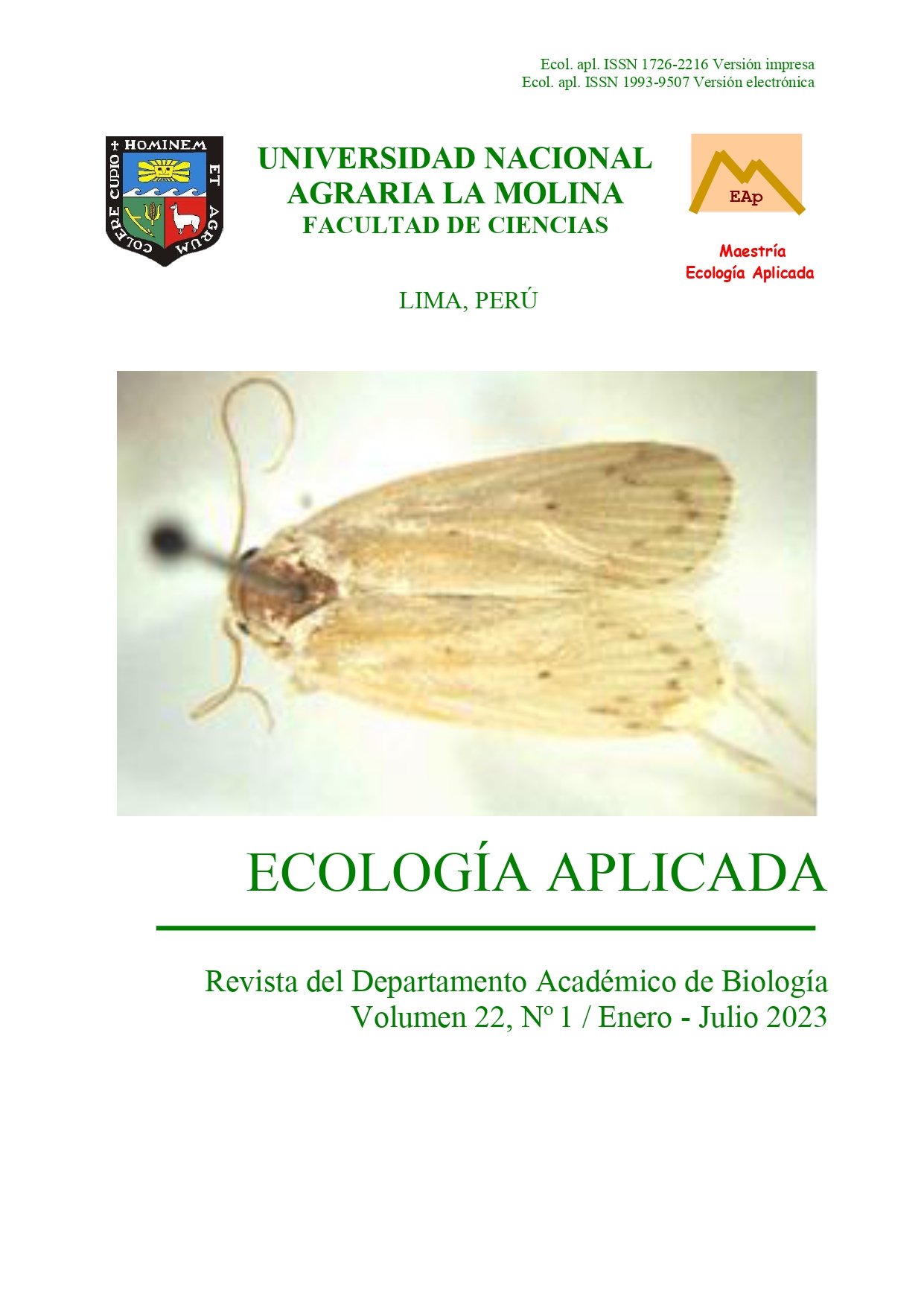SPATIAL DISTRIBUTION AND ABUNDANCE OF Balliviaspongia wirrmanni (SPONGILLIDAE) IN THE TITICACA NATIONAL RESERVE
DOI:
https://doi.org/10.21704/rea.v22i1.2022Keywords:
quadrants, habitat, dispersion indicesAbstract
The objective of this study was to evaluate the spatial distribution and abundance of the only species of freshwater sponge from Lake Titicaca, Balliviaspongia wirrmanni, in the Titicaca National Reserve (RNT). The evaluations were carried out in the aquatic ecosystem of Lake Titicaca, through the random application of quadrats of one m2. In each individual cattail (Schoenoplectus tatora) present in each quadrat, the presence of sponges was evaluated to perform the count. The results were contrasted according to time periods and study areas. Average sponge counts were higher in the RNT zone, with 485 sponges, and lower in the Puno - Capachica zone, with 47 sponges (P < 0.001), with uniform and contagious Morisita dispersion indices, respectively. The abundance was higher in the RNT area with 43.35%, in the months of July and August. The obtained data suggest that sponges prevail in remote areas free of anthropic action and decrease in the proximity of towns and cities because different anthropic activities would be affecting their growth and development in the aquatic ecosystem of Lake Titicaca.
Downloads
References
Beltrán D.F., Palomino R.P., Moreno E.G., Peralta C.G. & Montesinos-Tubée D.B. 2015. Calidad de agua de la bahía interior de Puno, lago Titicaca durante el verano del 2011. Revista Peruana de Biología, 22(3): 335-340. https://www.redalyc.org/pdf/1950/195043168009.pdf
Boury N. & Volkmer C. 1991. Las esponjas (Cap. VI.4b). En: Dejoux C. & Iltis A. (Eds) El Lago Titicaca: Síntesis del conocimiento limnológico actual. 305-310. OSTOM & HISBOL. La Paz, Bolivia. https://horizon.documentation.ird.fr/exldoc/pleins_textes/divers08-10/36603.pdf.
Cabrera H. & Wallace R. 2007. Densidad y distribución espacial de palmeras arborescentes en un bosque preandino - amazónico de Bolivia. Ecología en Bolivia, 42(2): 121-135. http://www.scielo.org.bo/pdf/reb/v42n2/v42n2a04.pdf.
CIRNMA & CEDAFOR. 2001. Informe final: Plan Maestro Reserva Nacional del Titicaca. Proyecto PER/98/G32: Conservación de la Biodiversidad en la Cuenca del Lago Titicaca-Desaguadero-Poopo-Salar de Coipasa TDPS. 3- 73. CIRNMA (Centro de Investigación de Recursos Naturales y Medio Ambiente) & CEDAFOR (Centro de Desarrollo Agrario y Forestal). http://www.alt perubolivia.org/Web_Bio/PROYECTO/Docum_peru/21 .27%20Plan%20Maestro.pdf.
Dejoux C. & Iltis A. (Eds). 1991. El lago Titicaca, síntesis del conocimiento limnológico actual. 305-310. ORSTOM & HISBOL. La Paz / Bolivia. https://horizon.documentation.ird.fr/exldoc/pleins_textes/divers08-10/36603.pdf.
Di Rienzo A., Casanoves F., Balzarini G., Gonzalez L., Tablada M. & Robledo W. 2020. InfoStat versión 2020. Centro de Transferencia InfoStat, FCA, Universidad Nacional de Córdoba, Argentina. http://www.infostat.com.ar.
Dröscher I. & Waringer J. 2007. Abundance and microhabitats of freshwater sponges (Spongillidae) in a Danubean floodplain in Austria. Freshwater Biology, 52(6): 998-1008. http://dx.doi.org/10.1111/j.1365- 2427.2007.01747.x.
Erpenbeck D. & Worheide G. 2007. On the molecular phylogeny of sponges. Zootaxa, 1668(1): 107-126. https://doi.org/10.11646/zootaxa.1668.1.10.
Gamarra C. 2017. Lago Titicaca: Importancia, estado de conservación y amenazas. Presentacón en la CELEBRACIÓN DEL DÍA MUNDIAL DE LOS HUMEDALES 2017: Humedales para la reducción del riesgo de desastres. Puno / Perú. IMARPE (Instituto del Mar del Perú). http://siar.minam.gob.pe/puno/sites/default/files/archivo s/public/docs/1510.pdf.
Gammons H., Slotton G., Gerbrandt B., Weight W., Young A., McNearny L., Cámac E., Calderón R. & Tapia H. 2006. Mercury concentrations of fish, river water, and sediment in the Río Ramis – Lake Titicaca watershed, Perú. Science of the Total Environment, 368(2-3): 637- 648. https://dx.doi.org/10.1016/j.scitotenv.2005.09.076.
IANP (Intendencia de Áreas Naturales Protegidas). 2005. RESERVA NACIONAL DEL TITICACA. Plan de Uso Turístico de la Reserva Nacional del Titicaca. Rev. FMV. 7-32. SERNANP. Perú. http://old.sernanp.gob.pe/sernanp/archivos/biblioteca/pla nes_de_uso_turistico/titicaca/Titicaca.pdf.
INRENA. 1996. Evaluación de la contaminación del lago Titicaca. Colección de informes. INRENA. https://hdl.handle.net/20.500.12543/1565.
Lavenu A. 1981. Origine et évolution néotectonique du lac Titicaca. Revue d'Hydrobiologie Tropicale, 14(4): 289- 297.
Lucey J. & Cocchiglia L. 2014. Distribution of sponges (Porifera: Spongillidae) in southern Irish rivers and streams. Proceedings of the Royal Irish Academy, 114B(2): 89-100. https://doi.org/10.3318/bioe.2014.24. https://www.jstor.org/stable/10.3318/bioe.2014.24.
Manconi R. & Pronzato R. 2016. Phylum Porifera (Chapter 3). In: Thorp J. & Rogers D.C. (Eds.). Thorp and Covich's Freshwater Invertebrates; vol. II: Keys to Neartic Fauna. (Fourth Edition). 39-83. Elsevier. Amsterdam. https://doi.org/10.1016/B978-0-12-385028-7.00003-2.
Morales J., Monteoliva A. & Criado A. 2020. Aportaciones ecológicas sobre esponjas dulceacuícolas (Porifera; Spongillidae) del río Ebro en Burgos. Nueva cita de Ephydatia muellei. Munibe Cienc. Nat., 68: 249-257. http://www.aranzadi.eus/fileadmin/docs/Munibe/mcn.20 20.68.16.pdf.
PNUD (Programa de las Naciones Unidas para el Desarrollo) & TDPS (Autoridad Binacional Autónoma del Sistema Hídrico). 2003. Guía Técnica: Reproducción y crianza de género Orestias. http://www.alt perubolivia.org/Web_Bio/PROYECTO/Docum_bolivia/ 21.05_guia.pdf.
Quispe D. & Aravena C. 2021. Interacción con la Reserva Nacional del Titicaca y percepción de la problemática ambiental. Economía Agraria y Recursos Naturales, 21(1): 35-58. https://doi.org/10.7201/earn.2021.01.02.
Richard E. & Contreras D. 2011. Las esponjas del Titicaca. Revista Abismo Sur, 1(13): 51-53. https://bit.ly/3wTAKCh. https://www.academia.edu/20999015/Las_esponjas_del _Lago_Titicaca.
Richard E. 2010a. Crónica de una muerte anunciada. I. La keñola del Titikaka: Rollandia microptera (Reptiles [ex Aves]: Podicipediformes). Ambiente y Biota de Bolivia, Boletín N° 1. https://bit.ly/3wSMAwn.
Richard E. 2010b. Crónica de una muerte anunciada. II. La keñola del Titikaka: Rollandia microptera (Reptiles [ex Aves]: Podicipediformes). Ambiente y Biota de Bolivia, Boletín 1(2): 1-27. https://bit.ly/38sMmmq.
Richard E. 2010c. Crónica de una muerte anunciada. III. La maravillosa esponja endémica del Lago Titikaka: Balliviaspongia wirrmanni Boury-Esnault y Volkmer Rivero 1991. Ambiente y Biota de Bolivia, Boletín 1(3): 6–12. DOI: 10.13140/2.1.5086.9441.
RNT (Reserva Nacional del Titicaca). 2014. Resolución Presidencial Nº 249-2014-SERNANP que aprueba actualización del Plan Maestro período 2014 - 2019 de la Reserva Nacional del Titicaca 2014 – 2019. Lima. El Peruano, 5 de noviembre. https://www.gob.pe/institucion/sernanp/normas legales/424226-rp-249-2014-sernanp. https://cdn.www.gob.pe/uploads/document/file/507275/- 410180746743245807120200203-11250- 1u2g8hi.pdf?v=1580748907.
Rueda J. & Mesquita F. 2018. Nuevas aportaciones al conocimiento de macroinvertebrados de agua dulce de Costa Rica y Nicaragua, con especial énfasis en las esponjas. Anales de Biología, 40: 9-18. DOI: 10.6018/analesbio.40.02.
SENAMHI. 2020. Tiempo, pronóstico del tiempo. SENAMHI (Servicio Nacional de Meteorología e Hidrología del Perú). [página web]. URL: https://www.senamhi.gob.pe/main.php?dp=puno&p=pro nostico-detalle.
SERNANP, Servicio Nacional de Áreas Naturales Protegidas por el Estado – Perú. 2019. Reserva Nacional del Titicaca. https://www.gob.pe/institucion/sernanp/informes publicaciones/1749491-reserva-nacional-del-titicaca.
Tarqui C., Alvarez D. & Fernández I. 2016. Yoduria y concentración de yodo en sal de consumo en escolares peruanos del nivel primario. Rev. Peru. Med. Exp. y Salud Publica, 33(4): 689-694. DOI: 10.17843/rpmesp.2016.334.2552
UNMSM–MHN (Universidad Nacional Mayor de San Marcos Museo de Historia Natural). 2014. Métodos de colecta, identificación y análisis de comunidades biológicas: plancton, perifiton, bentos (macroinvertebrados) y necton (peces) em aguas continentales del Perú. Ministerio del Ambiente. Lima / Perú. https://www.minam.gob.pe/diversidadbiologica/wp content/uploads/sites/21/2014/02/M%C3%A9todos-de Colecta-identificaci%C3%B3n-y-an%C3%A1lisis-de comunidades-biol%C3%B3gicas.compressed.pdf.
Downloads
Published
Issue
Section
License
Copyright (c) 2023 Faustina Eliana Quenta Choque, Sandra Lisbet Benavente Farfán , Buenaventura Optaciano Carpio Vásquez , Juan José Pauro Roque, Xiomara Daneysa Aguilar Quenta, Jesús Michael Llahuilla Quispe, Gimena Idme Esteban Anquise, Gloria Lisbeth Gutiérrez Álvarez

This work is licensed under a Creative Commons Attribution-NonCommercial 4.0 International License.



